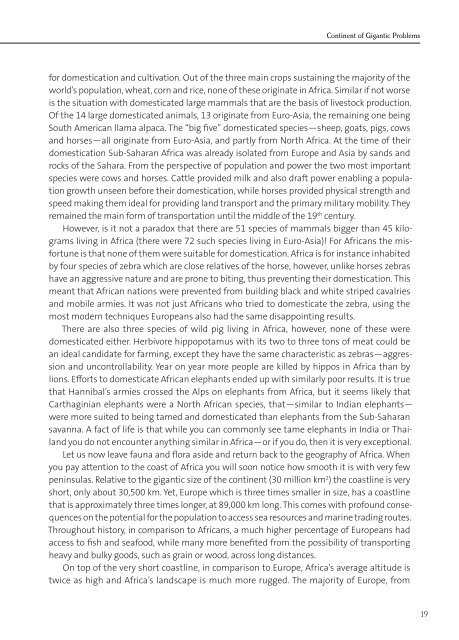Giant_and_Dwarf-FIN
Giant_and_Dwarf-FIN
Giant_and_Dwarf-FIN
You also want an ePaper? Increase the reach of your titles
YUMPU automatically turns print PDFs into web optimized ePapers that Google loves.
Continent of Gigantic Problemsfor domestication <strong>and</strong> cultivation. Out of the three main crops sustaining the majority of theworld’s population, wheat, corn <strong>and</strong> rice, none of these originate in Africa. Similar if not worseis the situation with domesticated large mammals that are the basis of livestock production.Of the 14 large domesticated animals, 13 originate from Euro-Asia, the remaining one beingSouth American llama alpaca. The “big five” domesticated species—sheep, goats, pigs, cows<strong>and</strong> horses—all originate from Euro-Asia, <strong>and</strong> partly from North Africa. At the time of theirdomestication Sub-Saharan Africa was already isolated from Europe <strong>and</strong> Asia by s<strong>and</strong>s <strong>and</strong>rocks of the Sahara. From the perspective of population <strong>and</strong> power the two most importantspecies were cows <strong>and</strong> horses. Cattle provided milk <strong>and</strong> also draft power enabling a populationgrowth unseen before their domestication, while horses provided physical strength <strong>and</strong>speed making them ideal for providing l<strong>and</strong> transport <strong>and</strong> the primary military mobility. Theyremained the main form of transportation until the middle of the 19 th century.However, is it not a paradox that there are 51 species of mammals bigger than 45 kilogramsliving in Africa (there were 72 such species living in Euro-Asia)! For Africans the misfortuneis that none of them were suitable for domestication. Africa is for instance inhabitedby four species of zebra which are close relatives of the horse, however, unlike horses zebrashave an aggressive nature <strong>and</strong> are prone to biting, thus preventing their domestication. Thismeant that African nations were prevented from building black <strong>and</strong> white striped cavalries<strong>and</strong> mobile armies. It was not just Africans who tried to domesticate the zebra, using themost modern techniques Europeans also had the same disappointing results.There are also three species of wild pig living in Africa, however, none of these weredomesticated either. Herbivore hippopotamus with its two to three tons of meat could bean ideal c<strong>and</strong>idate for farming, except they have the same characteristic as zebras—aggression<strong>and</strong> uncontrollability. Year on year more people are killed by hippos in Africa than bylions. Efforts to domesticate African elephants ended up with similarly poor results. It is truethat Hannibal’s armies crossed the Alps on elephants from Africa, but it seems likely thatCarthaginian elephants were a North African species, that—similar to Indian elephants—were more suited to being tamed <strong>and</strong> domesticated than elephants from the Sub-Saharansavanna. A fact of life is that while you can commonly see tame elephants in India or Thail<strong>and</strong>you do not encounter anything similar in Africa—or if you do, then it is very exceptional.Let us now leave fauna <strong>and</strong> flora aside <strong>and</strong> return back to the geography of Africa. Whenyou pay attention to the coast of Africa you will soon notice how smooth it is with very fewpeninsulas. Relative to the gigantic size of the continent (30 million km 2 ) the coastline is veryshort, only about 30,500 km. Yet, Europe which is three times smaller in size, has a coastlinethat is approximately three times longer, at 89,000 km long. This comes with profound consequenceson the potential for the population to access sea resources <strong>and</strong> marine trading routes.Throughout history, in comparison to Africans, a much higher percentage of Europeans hadaccess to fish <strong>and</strong> seafood, while many more benefited from the possibility of transportingheavy <strong>and</strong> bulky goods, such as grain or wood, across long distances.On top of the very short coastline, in comparison to Europe, Africa’s average altitude istwice as high <strong>and</strong> Africa’s l<strong>and</strong>scape is much more rugged. The majority of Europe, from19


